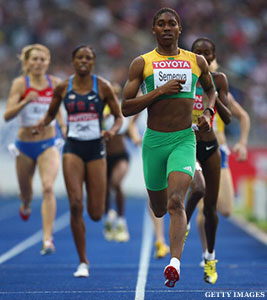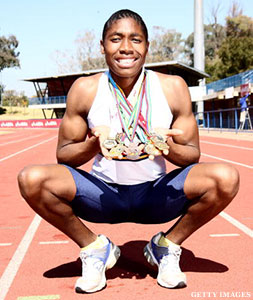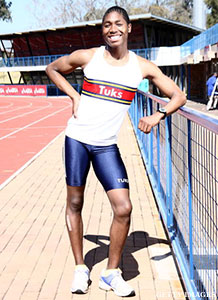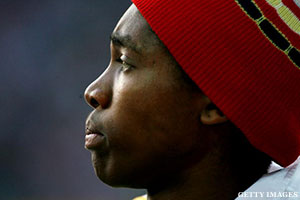
Caster Semenya never set out to be the face of an international debate over gender politics in sports. But when the South African track star won the gold in the women's 800 meter race at the 2009 World Championships in Berlin, she didn't have much of a choice.
At the 2009 World Championships, Semenya set the record for the fastest time that year, 1:55:45, an eight second improvement over her personal best. Her time, combined with her noticeably masculine build, aroused some bitter suspicion from the competition, including Italian runner Elisa Cusma Piccione and Russian Mariya Savinova, who called her a man.
The International Association of Athletics Federation (IAAF) also took notice. They asked Semenya to take a gender test after her gold medal win -- a medal she almost snubbed from embarrassment and hurt over the test.
South Africans, including the sports minister, were outraged. Many claimed the complaints were rooted in racism and since then, the eligibility of female athletes with hyperandrogenism, a condition where the female body produces abnormal levels of testosterone, has become a hot button issue in global sports.

These days, Semenya hopes to sprint beyond the controversy to a win at the London Games. Her return comes at a pivotal time when the International Olympic Committee is soon expected to announce new policies on the eligibility of women with hyperandrogenism, possibly banning them altogether.
In 2011, two years after Semenya's traumatic gender verification testing, the IAAF adopted new regulations which allow female athletes with hyperandrogenism to compete in women's sports as long as her androgen levels are below those of a man's. If her androgen levels are within the male range, the athlete would have to also have androgen resistance which prevents her from gaining a competitive advantage from the increased levels. An athlete who arouses scrutiny could be subject to a full evaluation - and if she declines or refuses, she would be banned from competition. Athletes with the condition who may have an advantage, such as increased muscle mass or level of red blood cells, would have to undergo hormone therapy or even have surgery to be eligible.
Semenya went through treatment, and at recent competitions, the media has marveled at her new, more feminine appearance.
"She wears a tight turquoise polo over her fit, feminine body. Relaxed, poised and, it must be said, pretty, the young woman with an irresistible smile is almost unrecognizable from photographs taken during the height of the controversy," Stephanie Findlay of the Toronto Star wrote.

It almost sounds as if Findlay is describing a Hollywood star strutting down the red carpet after a successful diet, not an athlete who should be judged on ability. That's precisely the problem. Should the IAAF, and now the IOC, be "policing femininity"? Does a female athlete need to resemble the Anna Kournikova or Amanda Beard? If Semenya had looked more feminine when she won her World Championship, would the competition have been so upset?
Those who make the rules , like the IAAF and the IOC, would never exactly base eligibility on looks, and rightfully so. So they look to testosterone levels. But some researchers argue testosterone levels aren't as black and white as the governing bodies need them to be in order to set policy. In a recent New York Times column, "You Say You're a Woman? That Should Be Enough," Columbia University Associate Professor Rebecca Jordan-Young and Stanford University senior research scholar Katrina Karkazis argue, "Testosterone is not the master molecule of athleticism. One glaring clue is that women whose tissues do not respond to testosterone at all are actually overrepresented among elite athletes. As counterintuitive as it might seem, there is no evidence that successful athletes have higher testosterone levels than less successful ones."

The researchers call for all women recognized as women by their birth certificates to be eligible to compete in women's sports. Women with hyperandrogenism aren't cheating, so why should they be disqualified for having more athletic bodies, which aren't necessarily a perfect recipe for winning, anyway?
"Women who have been ensnared by sex-testing dragnets have often been impressive, but not out of line with other elite female athletes," Jordan-Young and Karkazis write.
Why not disqualify LeBron James for being superbly tall and fast? That question is posed in another Times column as part of a series on gender testing for athletes.
"When men are more talented than others, it is an expression of the beauty of sports," writes Eric Vilain, director of the Institute of Society and Genetics at UCLA. "But when women outcompete others, suspicions about eligibility and arguments for a level playing field often arise."

As Vilain argues, banning a female athlete with the genetic advantage of increased testosterone from competing would hardly be different from banning a woman with the genetic advantage of height. He says, although it isn't a perfect parameter, women with higher than normal testosterone levels should be able to compete with other women, as long as the levels do not reach those of a man.
Of course, global sports organizations have to adopt clear policies for athletes and attempt to create the most even playing field possible. But when the waters are as murky as they are with gender testing, is it possible to be clear and even? In Semenya's case, former IAAF policies plagued a young woman with public scrutiny and kept her from competing for a year. Perhaps it's impossible for any governing body in sports to enact gender policies that make flawless scientific and ethical sense, but if the new policies shield athletes from gender bashing and embarrassment, it's a step in the right direction.




